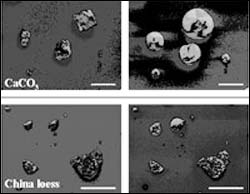The secret life of acid dust

FACE-CHANGING DUST-In the presence of water vapor, calcite crystals (left columns) react with nitric acid to form liquid calcium nitrate particles (right columns). These electron microscopy images illustrate the formation of these new particles in laboratory-controlled experiments with commercial calcite powders (top) and in a sample of authentic dust (bottom), loess collected in a region of China where the loamy soil is high in calcium and particularly reactive. (Images by Alexander Laskin, Pacific Northwest National Laboratory.)
Team discovers large, new class of airborne particles unaccounted for in climate models
Dry dust reacts with air pollutants to form dewy particles whose sunlight-reflecting and cloud-altering properties are unaccounted for in atmospheric models. “Calcite-containing dust particles blow into the air and encounter gaseous nitric acid in polluted air from factories to form an entirely new particle of calcium nitrate,” said Alexander Laskin, a senior research scientist at the Department of Energy’s Pacific Northwest National Laboratory in Richland, Washington.
“These nitrates have optical and chemical properties that are absolutely different from those of originally dry dust particles, and climate models need to be updated to reflect this chemistry.” Calcite dust is ubiquitous in arid areas such as Israel, where this past winter Laskin and colleagues Vicki Grassian, chemistry professor at the University of Iowa, and Yinon Rudich, professor of environmental sciences and energy research at the Weizmann Institute of Science, collected particles for analysis. Laskin presented their findings Tuesday at the American Geophysical Union fall meeting.
Working from a mountaintop, the team collected dust that had blown in from the northern shores of Egypt, Sinai and southern Israel. The particles had mingled with air containing pollutants that originated from Cairo. They analyzed nearly 2,000 individual micron-sized particles and observed the physical and chemical changes with an array of techniques at the W.R. Wiley Environmental Molecular Sciences Laboratory at PNNL.
A key change in the properties of the newly formed nitrate particles is that they begin to absorb water and retain the moisture. These wet particles can scatter and absorb sunlight — presenting climate modelers, who need to know where the energy is going, a new wild card to deal with. Companion studies of dust samples from the Sahara and the Saudi coast and loess from China show that the higher the calcium in the mineral, the more reactive they are in with nitric acid. And once the particle is changed, it stays that way.
“When dust storms kick up these particles and they enter polluted areas, the particles change,” Laskin said. “To what extent this is happening globally, as more of the world becomes industrialized, we don’t know. But now we have the laboratory and field evidence that shows it is definitely happening. The story is much more complicated than anybody thought.”
Media Contact
More Information:
http://www.pnl.govAll latest news from the category: Earth Sciences
Earth Sciences (also referred to as Geosciences), which deals with basic issues surrounding our planet, plays a vital role in the area of energy and raw materials supply.
Earth Sciences comprises subjects such as geology, geography, geological informatics, paleontology, mineralogy, petrography, crystallography, geophysics, geodesy, glaciology, cartography, photogrammetry, meteorology and seismology, early-warning systems, earthquake research and polar research.
Newest articles

Magnetic Effect: Groundbreaking Discovery for Low-Temperature Thermoelectric Cooling
Researchers at the Max Planck Institute for Chemical Physics of Solids, in collaboration with Chongqing University and the Max Planck Institute of Microstructure Physics, have achieved a breakthrough in topological…

Parallel Paths: Understanding Malaria Resistance in Chimpanzees and Humans
The closest relatives of humans adapt genetically to habitats and infections Survival of the Fittest: Genetic Adaptations Uncovered in Chimpanzees Görlitz, 10.01.2025. Chimpanzees have genetic adaptations that help them survive…

You are What You Eat—Stanford Study Links Fiber to Anti-Cancer Gene Modulation
The Fiber Gap: A Growing Concern in American Diets Fiber is well known to be an important part of a healthy diet, yet less than 10% of Americans eat the minimum recommended…



